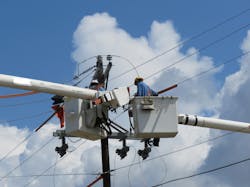Human Performance Improvement: Reduce Risk, Boost Safety
Our industry has developed a reliable, working electric grid along with a highly skilled workforce to operate it. We have shown a remarkable ability to analyze, understand and learn from our problems. But our industry is also changing dramatically, along with our customers.
New, potentially disruptive technologies are being introduced and our customers are asking us to do more and more to keep networks online and resilient. To meet this demand, we are introducing more people with new skills into our companies, and it does not appear that the trend will stop. Incorporating Human Performance Improvement (HPI) techniques and training into our already strong safety culture will provide processes and tools to help these smart people become productive faster and contribute in ways we have not imagined before.
Simply put, HPI anticipates what human errors can take place on a job and puts defenses in place that can reduce errors and injuries. We often assume we’re doing the right things or that the right things are being done by others. Yet we can unknowingly create error traps and put our people in a situation with a high probability for failure. An example might be when we do not schedule an appropriate amount of time to complete an outage, creating time pressure for our people in the field.
Dr. James Reason, author of Human Error wrote: “Rather than being the main instigators of an accident, operators tend to be the inheritors of system defects created by poor design, incorrect installation, faulty maintenance and bad management decisions. Their part is usually that of adding the final garnish to a lethal brew whose ingredients have already been long in the cooking.”
How HPI Works
Take the following simple illustrations of how HPI works. Driving a vehicle involves risk. Consider going over railroad tracks at a crossing without warning arms, bells or lights on a dark, stormy night in a remote area. You have a low ability to detect an oncoming train. On a clear, sunny day, your ability to see an oncoming train and hear its warning horn are much improved. You have much less risk in crossing the tracks. But in both scenarios, successfully crossing the tracks is dependent on the driver’s actions.
Consider another track crossing. The railroad has installed railroad crossing signs, arms, lights and bells to alert you to oncoming trains. The railroad also conducts an aggressive ad campaign to warn of the dangers at rail crossings. Local laws restrict the speed of trains and times they can run in heavily traveled areas. Your vehicle is equipped with airbags and other safety devices to reduce injuries in a potential accident. Your ability to detect an oncoming train is vastly improved and your risk is much lower.
This is an example of how organizations, rather than individuals, often have the greatest opportunity and ability to decrease risk through action and design to help individuals complete the crossing successfully.
Whether in the power industry or another, the HPI process investigates the inputs that could create errors. We are then able to reorganize our teams by using the processes and tools that are recommended because of a thorough after-action review or pre-action planning.
We can clarify roles and responsibilities, revise processes and procedures and create high-performance teams. This allows the teams to take advantage of everyone’s strengths and complementary skills. Understanding the potential error traps allows the team to budget more accurately, schedule everyone’s time more effectively and communicate more clearly to each other resulting in reduced risk and a remarkable return on investment.
Embrace HPI
Utilities across the United States are embracing HPI much like they embrace safety. In 2011, the North American Reliability Corp. and the North American Transmission Forum held their first conference on “Improving Human Performance and Increasing Reliability on the Bulk Power System” in Atlanta, which drew 85 participants.
In 2018, 432 people attended the conference representing almost every major utility in America. The 15 utilities making presentations at that conference were among the country’s largest and most progressive companies. Adding to the emphasis, HPI will be highlighted at the 2019 IEEE-ESMO conference in Columbus, Ohio, U.S., June 24-27.
HPI tools and education enable companies to increase their employees’ success by unearthing hidden flaws in their inter-organizational communications, processes and work habits. But the greatest contribution to companies is the lasting positive effect on a company’s culture by increasing transparency, communication, accountability and trust among all employees. Along with amazing intangible results, dedicated companies will realize a tangible, better return on investments through the efficiencies created, while achieving greater safety results and enhancing operational and maintenance skills.
Learning from our errors, making the right adjustments and using the lessons to improve our forward-thinking processes, planning and execution of work are the ultimate win for all. Human Performance Improvement is for everyone and every profession who delivers power, ultimately making our lives better.
About the Author
Shayne Wright
Shayne Wright is vice president, Power Delivery Division, with POWER Engineers, Inc.
